by Elana Hagler
[table caption=”Apollo and Dionysus” width=”610″ colwidth=”305|305″ colalign=”center|center”]This essay explores the subconscious impulses behind aesthetic choice and offers a framework for a deeper understanding of contemporary representational painting. It is written by a painter with a readership of painters in mind, but is appropriate for anyone who wants this specific peek into the creative psyche.
“Apollo and Dionysus in the Representational Painting Family Feud” was published on December 24, 2014 in Kitsch & Beauty: The Proceedings of The Representational Art Conference 2014, edited by Michael J. Pearce, PhD, MFA.
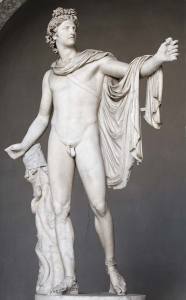 ,
,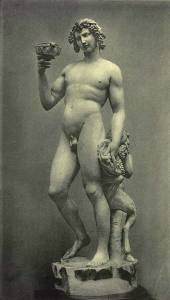
Apollo Belvedere after Leochares circa 120-140 marble (copy of bronze original of ca. 350-325 BC), Bacchus – Michelangelo 1496-7 marble.
[/table]
Why do specific stylistic approaches in representational art occasion so much vitriol between different artistic camps? Friedrich Nietzsche’s Apollonian/Dionysian dialectic, described in The Birth of Tragedy, offers insight into the subconscious sources of our aesthetic biases. Broadly speaking, Apollonian traits are civilizing, analytical, and constructive, while Dionysian traits are chaotic, ecstatic, and destructive. By organizing contemporary representational painting into the three fluid categories of classical, observational, and constructed, and then analyzing each category in relation to Nietzsche’s dialectic, we come to see the deeply rooted psychological and philosophical underpinnings of aesthetic choice. We see further that the strong reactions that many viewers hold in relation to specific painting styles are tied to their own positions relative to those styles on the Apollonian/Dionysian continuum. Polarities such as chaos and order, closed-form and open-form, muted tones and saturated color, and flatness and the illusion of depth are all understood within the Apollonian/Dionysian context to help us explore the ranges within each of the three representational painting categories, and to demonstrate how the categories relate to one another. We come to see that these types of stylistic choices should not, in and of themselves, call into question a painting’s quality and/or validity, but are rather an expression of the artist’s position along the Apollonian/Dionysian continuum.
Why is it that so many respected and established artists are at each other’s throats over matters as seemingly insignificant as whether a painting had hard edges or softer, more broken up edges? Some painters seem to take the work of others as some kind of a personal affront, as opposed to simply an expression of that specific artist’s painterly preferences. The word “Nazi” is tossed about fast and loose, and sometimes art school critiques turn into high-pitched shriek fests where grown professionals try to prove that a student’s work (and sometimes implicitly the work of that student’s main mentor) is not merely bad; it is invalid.
Every year we hear more and more stories of outrageously unprofessional behavior arising out of aesthetic disagreements. One of my personal favorites happened at a well-known art school. At this school, the main gallery would rotate shows so that each member of the faculty would eventually get a chance to display his or her work. When it came time for one painter, a full professor, to have her show, there was a fuss made at the department meeting. Her work was hard-edged, tonal, and highly detailed. “Is there any way,” a fellow painting professor proposed, “that we could just have a sign displayed in the window letting people know that this kind of work does not represent the institution?”
For decades now, it has been widely asserted that any type of realism (which is in itself a loaded word) is passé, and therefore it has been actively marginalized by many mainstream critics and contemporary art institutions. Established artists and college professors have still been so busy fighting the man and shocking the bourgeoisie that they have not noticed that the anti-academics now were the man. So, when representational painting seems already to have been largely marginalized, why are people working within that tradition also at each other’s throats?
The deeper reasons for this antagonism, and, in fact, the subconscious impulses behind aesthetic choice, become apparent when we look at Nietzsche’s description of the Apollonian/Dionysian dialectic in The Birth of Tragedy. In his book, Nietzsche explains that the form art takes (he specifically deals with Greek tragedies) is in direct relation to Man’s response to reality. He believes that aesthetics address the question of what our response should be to the nature of life. This, of course, begs the question of how Nietzsche views reality. As he is examining the Greek view in this case, it is a specifically pagan as opposed to a Judeo-Christian point of view. Instead of a single God on high, creating order out of primordial chaos, there are competing gods, with competing moral positions, constantly engaged in various conflicts and endeavors. Nietzsche does not separate aesthetics, ethics, or metaphysics; they remain deeply entangled, for he believes that to separate any from the others is to diminish each. So here we have this pagan worldview: rather than an imposed moral order, we have a moral order that is arising out of competition and interaction. What is reality? Reality is creatures coming into existence, eating, sleeping, fornicating, competing and cooperating, breeding, and expiring, and this chaotic cycle of life continues on and on. Man has developed various means of coping with the ways of nature. While there are more responses than just the Apollonian and the Dionysian, these are the two with which Nietzsche explains the dynamics at play in works of art.
Apollo is the Greek god of dreams, prophecy, medicine, archery, intellectual inquiry, light, and the arts such as music, poetry, and dance. Apollonian qualities in painting include the use of lines, closed form, multiplicity, tonalism, and the impression of stillness. The Apollonian impulse is governed by the rational mind which makes divisions in order to grasp meaning. In contemporary thought, we tend to think of these qualities as more left-brained, although recent research shows that the halves of the brain are much more interrelated than previously supposed.[1] Nietzsche equates the Apollonian to the world of dreams, which no matter how compelling or seemingly immersive, is ultimately illusionary. “The beautiful illusion of the dream worlds,” Nietzsche asserts, “in the creation of which every man is a consummate artist, is the precondition of all visual art….We take pleasure in the immediate apprehension of form, all shapes speak to us, and nothing is indifferent or unnecessary.”[2] Thus, Nietzsche’s Apollonian Man copes with the reality of the chaos of being by restructuring it into an illusory vessel of meaning. The artworks resulting from this coping mechanism permit an interpretation of life as well as a training ground in which the conflicts of life can play out.
Dionysus, another son of Zeus, is also a Greek god of art, but more associated with theatre. He is the god of wine and intoxication, agriculture, the fertility of nature, and of the ecstatic worship and secret rites of mystery religions. Dionysian qualities in painting include emphasis on the materiality of the paint (painterliness), open form, a sense of wholeness, colorist painting, and the impression of movement. We can think of these traits as the right-brained counterparts of the Apollonian qualities. The Dionysian is impulse governed by the emotional mind which responds to the chaotic flux of being not by resisting it but by mimicking that reality—in a sense, by becoming a part of it. Rather than to fight nature, the goal becomes to harness its creative power.
To help us understand these competing dynamics, Nietzsche turns to a parable from Schopenhauer of Man enveloped in the veil of Maya.
“Just as the boatman sits in his little boat, trusting to his fragile craft in a stormy sea which, boundless in every direction, rises and falls in howling, mountainous waves, so in the midst of a world full of suffering the individual man calmly sits, supported by and trusting the principium individuationis.”[3]
The principium individuationis, or the principle of individuation, describes the way in which any specific thing is distinguished from other things. For instance, I see the laptop on which I am writing as distinct from the table on which is it sitting. In the same way, the principle of individuation can allow me to see myself as a person who is separate from you, and thus I can relate to you on that basis. I am I, you are you, the chair upon which I sit remains a chair, and thus I can relax that all is right with the world. Nietzsche proposes that “we might even describe Apollo as the glorious divine image of the principium individuationis, from whose gestures and looks all the delight, wisdom and beauty of ‘illusion’ speak to us.”[4] Schopenhauer goes on to describe how this comforting world of appearances might be cracked at times (if not ultimately shattered) when Man, with tremendous dread, is confronted with the underlying chaos of existence. This dread goes hand-in-hand with a state of blissful ecstasy, welling up from the reunification of Man with Nature. This state is the Dionysian aspect, as Nietzsche puts it: the world of intoxication as opposed to the world of dreams. This is the dreadful bliss of the maenads in their orgiastic frenzies of the worship of Dionysus, of dancers hypnotically losing themselves in the rhythmic pounding in the depths of the nightclub, of the intoxicating drumbeat of the rituals of aboriginal peoples, and of the feelings of oneness and bliss that can be attained through either meditation or riding a chemical high. The line between catastrophe and deepest bliss is one that is often blurred.
Perhaps the most immediately visible difference between Apollonian and Dionysian painting is that the former tends to be linear while the latter tends to be painterly. The first sees in terms of lines while the second sees in masses. In his Principles of Art History, Heinrich Wölfflin defined this contrast as follows:
“Linear vision, therefore, means that the sense and beauty of things is first sought in the outline—interior forms have their outline too—that the eye is led along the boundaries and induced to feel along the edges, where seeing in masses takes place where the attention withdraws from the edges, where the outline has become more or less indifferent to the eye as the path of vision, and the primary element of the impression is things seen as patches.”[5]
Usually, more linear painting also tends to be closed form as opposed to open form. The edge around forms is kept whole, and the principium individuationis holds sway, so that each object remains clearly defined as itself, and there is a clarity to its relationship to its neighbor as well as to the entirety of the elements in the composition. Open form paintings fit more into the realm of the Dionysian, where edges start to blur, rupture, and disintegrate, and the emphasis shifts from the specific to the general. Individual identity becomes less important than the entirety of the picture plane, the sense of the gestalt. With fewer edges on which our eye can catch, we zip around the painting at greater speed, creating a sense of motion and dynamism in the experience of viewing the work of art.
Motion and emotion are visually tied. More linear and closed-form paintings tend to have a quieter sort of reverie about them. The experience of vision can feel more detached, as if we observe the scene from a critical distance. As viewers, we enter the realm of analysis and objectivity. More painterly and open-form work, on the other hand, hints at exuberance. The experience of viewing becomes more immersive. The line between the viewer and the painting, just like the boundaries between depicted objects, starts to disintegrate. Wölfflin sees this shift to the painterly from the linear as “the distinguishing feature of the 17th century in comparison with the 16th.”[6] During this era, Renaissance art transitioned to the new dominant style of the Baroque. The Renaissance, of course, was deeply rooted in the rediscovery of classical Greek art and heavily influenced by the aesthetic ideas of Plato. Thus, in the depiction of each object or human figure, artists strove for a representation of an ideal form. Whereas art during the Renaissance strove for perfect proportion, with each form developed fully within itself while still interacting with the whole, Wölfflin describes a different set of goals in Italian Baroque art. “The relationships of the individual to the world has changed, a new domain of feeling has opened, the soul aspires to dissolution in the sublimity of the huge, the infinite.”[7]
[table caption=”Three Categories of Contemporary Figurative Painting” width=”684″ colwidth=”228|228|228″ colalign=”center|center|center”] Classical,Observational,Constructed
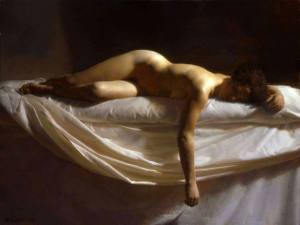 ,
,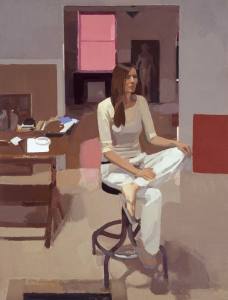 ,
,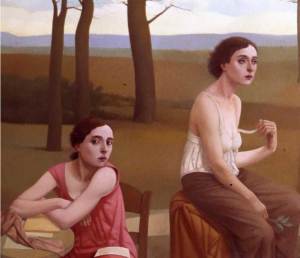
Jacob Collins Anna 2004,John Dubrow Tine 2009,Alan Feltus What Thoughts Do They Hide 2010-11
So how does contemporary representational painting relate to these dichotomies? I propose that representational painting today can be divided into three broadly-conceived categories: Classical, Observational, and Constructed. While fluid, these categories are useful to describe significant differences in both the appearance of paintings and the ways in which painters tend to think of their own work and that of others. Naturally, the work of many painters is a combination of two or even all three of these categories. Sometimes the same painter will have distinct bodies of work that may each fit into different categories. Oftentimes, the work of gifted painters is overlooked when it is not able to be neatly categorized by curators or critics who may not properly appreciate the complex ways in which these categories overlap in the given work. Looking more deeply into these categories can also help us to appreciate that work which straddles the lines. The analysis of where the work within these categories lies upon the Apollonian/Dionysian continuum can shed tremendous light on both the nature of the work and on the sometimes puzzling reactions that members of one camp can display toward the work of another.
Contemporary classical painting, also sometimes referred to as academic painting, embraces and attempts to build upon painting traditions of the past. Much of classical painting in America today is found in the growing atelier system, which traces its roots back to the height of the French Academy in the 19th-century, looking back at painters such as Jean-Léon Gérôme, William-Adolphe Bouguereau, and Carolus-Duran. Classical painters often see themselves as working to revive lost knowledge, rooted in traditional materials and tools, with an emphasis on technical skill as it relates to crafting a compelling illusion of realistic form and space and the pursuit of an ideal of beauty. Classical paintings are more likely to be painted indirectly, utilizing techniques such as monochromatic underpainting, glazing, and scumbling. Unlike much of the contemporary art world, classical painting often eagerly engages with issues of narrative. Thus, classical painting presents a more Apollonian vision of the world, with a time-honored way of structuring a painting that makes the illusion both believable and seductive. Such paintings frequently deal with allegory or the more outright depiction of a situation, lending themselves to the act of interpretation, and telling a story that has a point. Classical painting takes our fragmented reality and brings it into aesthetic harmony.
[table caption=”Classical Painting” width=”684″ colwidth=”228|228|228″ colalign=”center|center|center” ] [attr colspan=”3″][/table] [table th=”0″ width=”684″ colwidth=”228|228|228″ colalign=”center|center|center”]
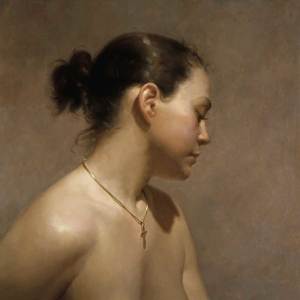 ,
,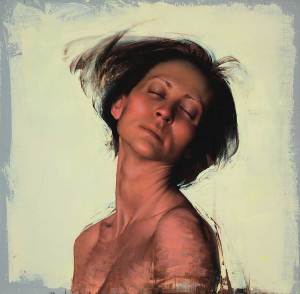 ,
,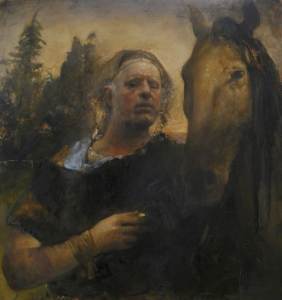
Jacob Collins Candace Profile 2004,Daniel Sprick Sherry 2012,Odd Nerdrum Self portrait at L’Hippodrome
[/table]
While classical painting as a whole tends to sit closer to the Apollonian side of the spectrum, there is a range within it that can be further explored. On the more Apollonian end of classical painting we can identify a painter such as Jacob Collins. Populating Collin’s figure paintings, nude models either lounge in bed, visually supported by artfully draped sheets, or contrast against a simple, airy wall. Most demurely look away from the viewer, offering themselves up for our viewing pleasure, ripe fodder for the ubiquitous critiques of the male gaze. The figures tend to be lit at the traditional forty-five degree angle. This controlled lighting situation, with that specific angle, has been used historically in painting because it provides great clarity in the depiction of form and space. Values are more easily broken down into highlight, light mass, midtone, coreshadow, and reflected light. Thus a systematic understanding of light is applied and a believable space is created that simultaneously describes the scene in front of the painter and harkens back to centuries of tradition. The colors tend to be lower in saturation while organized into a clear value hierarchy (tonalist painting) and the figures are highly rendered with exquisite detail. While the edges are not by any means harsh, these are clearly examples of closed form paintings. The angle of the lighting, the highly rendered details, and the closed edges all contribute to the individuation of the motif’s constituent parts.
Further along the spectrum towards the Dionysian, we find the work of Daniel Sprick. We are immediately more aware of the materiality of the paint, breaking the form here and there with splashes and drips. The paint becomes a more active, sensuous player in our visual experience, as we delight in its multiplicity of forms. While still classically lit, the figure is now enveloped in a glowing, numinous space that cannot be concretely tied to any specific physical location. We are somehow left with the impression that the sense of motion in the external environment is connected to the emotional state of mind of the model. There is no longer such a clear division between positive and negative space. Color from the flesh of the model intrudes into the space and the space likewise pushes into the model. With the more open form, our attention shifts from the particular to the overall composition, before coming back to indulge in the delicate rendering of the human form.
On the Dionysian end of classical painting, we encounter the work of Odd Nerdrum. Nerdrum’s subject matter tends to be more abrasive, often even shocking to more traditional viewers. Many of his paintings seem to tell a story or allegorically depict some of the less comforting aspects of the human condition. Nerdrum has embraced the term kitsch, used by his critics to deride the high level of drama and emotion in his subject matter. The paint is built up more thickly than in either Collins’ or Sprick’s work. Looking closely at the surface, one can see lower layers of paint peeking through, creating a rough, textured tapestry. The work remains tonalist, but glints of brighter colors surprise the eye. The lighting situation is no longer clear-cut; the glow feels more tied to mood and composition than to a closely observed, specific visual situation. The painting is more open form, with groupings of similar value and color taking our eyes off of the edges of depicted objects and sweeping us across the composition in broad movements. Air begins to take precedence over object.
With all of these Dionysian features, how do we know that Nerdrum’s work still fits under the classical painting grouping? There is first that narrative aspect, more present in his work than in that of Collins or Sprick. Then there is the matter of painting style that is inherited from tradition; Nerdrum’s paint application is very clearly akin to that of Rembrandt. With the rise of modernism, art criticism has put the onus on the artist to embody the meaning of the painting in the manipulation of the medium, calling for an invented rather than an inherited language of paint. Critics of classical painting view those painters as living in a kind of time capsule—rejecting the whole of modernism and post-modernism and indulging in a visual form of nostalgia.
The second category that we are exploring is observational painting. The term observational is often interchanged with the word perceptual. The idea is that these works are all rooted in the act of looking and responding to the motif. Of course, in classical painting, the artists are also often closely observing a scene in front of them, but with observational painting, the act of looking is given primacy. Values in this camp tend to stress a freshness of vision: a vision that is not wholly rooted in previously established artistic conventions. Like in other contemporary art practices, the words conventional and academic are tossed about as insults. This is, of course, not to say that observational painters have completely done away with convention. After all, painting as an activity is a cultural construct, and it cannot really be seen and understood without some sense of its relation to art history. Also, observational painters tend to look at historical painters from a wider time range than do classical painters. Walk into your prototypical observational painter’s studio and you are likely to find monographs from modern painters such as Edwin Dickinson and Giorgio Morandi side by side with books on early Renaissance masters Masaccio and Piero della Francesca, as well as a tome filled with the prehistoric cave paintings from Lascaux. While classical painting tends to be more associated with the atelier movement, observational painting has a strong foothold in various “studio schools” as well larger and older art institutions such as the Pennsylvania Academy of the Fine Arts and the Maryland Institute College of Art.
[table caption=”Observational Painting” width=”684″ colwidth=”228|228|228″ colalign=”center|center|center”] [attr colspan=”3″][/table] [table th=”0″ width=”684″ colwidth=”228|228|228″ colalign=”center|center|center”]
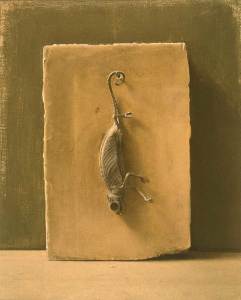 ,
,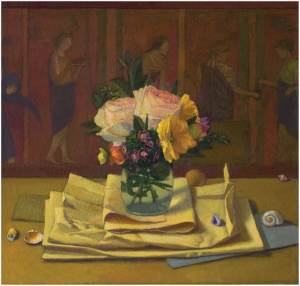 ,
,
Israel Hershberg The Chameleon 1997,Gillian Pederson-Krag Still Life 2007,Jordan WolfsonStill Life with Rosehips and Turquoise Bowl II2011
[/table]
On the more Apollonian end of observational painting we have the work of Israel Hershberg. Painters such as Hershberg, with extremely detailed and very much closed-form paintings, are sometimes derided by painters further on the Dionysian side of observational painting as being classical and even reactionary. Hershberg’s use of color in many of his still-lifes tends to be on the less saturated side, his vision of the world held together by a dusty sepia-tinged air. His subject matter tends to be enigmatic and unadorned, eschewing conventions of prettiness. The forms and textured surfaces are depicted in stark detail, revealing the inevitable erosion brought on by the passage of time. The mood is one of felt emotion that is always restrained, always pulsing underneath those scratched and worn and obsessively tended-to surfaces. Unlike many classical paintings, the surface of the painting does not glimmer under a thick layer of varnish. Observational painters are more likely to prefer a matte or semi-matte finish to their work. In part this is because of the nature of the way in which the image is built up. Hershberg, like many other observational painters, employs a mostly direct method of applying paint. He goes for the large color relationships that he sees right from the start of the painting process, rather than building up from a monochromatic underpainting with a series of glazes. I imagine that many of these painters shun a slicker surface because they like the way that a more matte surface looks, but why do so many observational painters seem to lean towards matte while classical painters are more likely to lean towards glossy? I believe that the first reason for this is that contemporary classical painters tend to look more at nineteenth-century French Academy paintings, which were often painted indirectly and finished off with a protective layer of varnish. In contrast, Hershberg looks back at the surfaces of the frescos of the early Renaissance, and even further back to the enigmatic Roman frescos gracing the crumbling walls of Pompeii.
But the division between classical and observational is of course more than just what era of history the painter tends to fetishize. There is also the matter of the painter’s relationship to certain basic tenets of modernism. With the fall of the French Academy and the rise of Impressionism and all of the subsequent “isms” of modern art, illusion (an Apollonian trait) became a feature that was derided. Whereas previously a painting had been conceived of as a window through which a convincingly real scene could be glimpsed, in the twentieth century the idea of flatness, of the importance of the surface of the painting, became a very conscious concern. In his highly influential 1960 essay “Modernist Painting,” critic Clement Greenberg asserted that flatness was the most essential and unique aspect of Modern painting.[8] Painters started deliberately calling attention to the flat nature of the surface of the canvas. Rather than an attempt to build a convincing illusion, the materials and the act of painting itself took center stage. “I’m not trying to sell you a bill of goods,” the painting proclaims. “I am pigment, suspended in a medium, arranged on a flat surface. What you see is what you get.” So, in a subtle nod to Modernism, Hershberg’s dry, fresco-like surfaces delicately draw attention to the flatness of the canvas, creating a tiny spark of conflict between a masterly depiction of deep space and the assertion of flatness.
The further we get towards the side of the Dionysian, the more emphasized the surface qualities tend to be in relation to the illusion of depth. We can see this tendency playing out beautifully when we look at the figure painting by classical painter Jacob Collins side-by-side with that of the observational painter John Dubrow. While the Collins figure is delicately rendered, smoothly guiding our eyes over rounded forms, the Dubrow figure and the surrounding space seem to be composed of starker patches and blocks of paint. The paint never fully gives over its own identity in the service of depiction. While there is certainly depth and space created in Dubrow’s painting, it sits in a delicious tension with the painterly, flat patches that cry out their own materiality. “You see,” the patches exclaim, “this scene we are showing you…it is just an illusion. We are all made of the same stuff as the rest of nature, and it and we are filled with eruptions and negations.” And the illusion of Maya ruptures a bit more.
Further toward the Dionysian pole under observational painting, we have the jewel-toned arrangements of Gillian Pederson-Krag. There are three main ways in which Pederson-Krag’s still-life is more Dionysian than that of Israel Hershberg: use of color, composition, and level of detail. Unlike the strongly tonal, low saturation colors in Hershberg’s painting, Pederson-Krag’s painting glows with vibrant, saturated color. The colors are still held together in a clear value structure, and of course certain areas of the painting have less saturated colors for compositional purposes, but the difference in saturation between the two paintings is clear. The psychology of color has been extensively studied and written about, and higher saturation in color is generally linked to more intense expression of emotion. While both still-lifes have a strong centrally focused composition, with the most intricate and attention catching objects placed right in the middle of the canvas, Pederson-Krag’s painting makes use of layers and rhythmic elements that move the viewer’s eyes more actively throughout the entire composition. If Hershberg’s painting has a lead actor (the dried chameleon) carrying most of the dialogue with a Greek chorus (the delicately textured surrounding surfaces) murmuring their support from afar, then Pederson-Krag’s painting has a main player that is constantly interacting with a more fleshed-out supporting cast. Our eye gets drawn from the bright colors of the flowers down into the highly value-contrasting rhythms of the folded and layered paper. The eye is caught for a moment on the playful glints of the seashells before rising up to the background progression of silent dancers, which carry the movement across the painting to the right, at which point we drop back down to the delicate swirl of the shell on the bottom right. Thus we have the contrast between focusing in on a central object (Apollonian) and the dispersion of a greater amount of attention to the entirety of the composition (Dionysian). Even though all observational painters are incredibly engaged with the act of looking at and responding to the motif, there is always a tremendous amount of editing and ordering that is taking place while painting. Each painter decides the level of detail to include or omit from the painting. Hershberg’s greater intricacy of detail puts the emphasis on the parts and their individuation, while Pederson-Krag’s stronger simplification of spots of color once again shifts the focus from the individual parts to their relationships, their interactions, within the whole.
These aforementioned shifts toward the Dionysian in Pederson-Krag’s work become even more extreme in the painting of Jordan Wolfson. The three primary colors—yellow, red, and blue—are more forcefully stated within the arrangement. There is no single, centrally placed object that is the main player on the stage: rather, we are clearly dealing with an ensemble cast. Closed form gives way to open form, with edges that are crumbling and in some places almost entirely disappear. All this contributes to a great sense of motion, with Wolfson leading our eyes in a mad, Bacchanalian dance across the richly pulsating surface. Negative space and positive space start to run together and the individual depicted objects vibrate to the tune of the chaotic flux of being.
[table caption=”Constructed Painting” width=”684″ colwidth=”228|228|228″ colalign=”center|center|center”] [attr colspan=”3″][/table] [table th=”0″ width=”684″ colwidth=”228|228|228″ colalign=”center|center|center”]
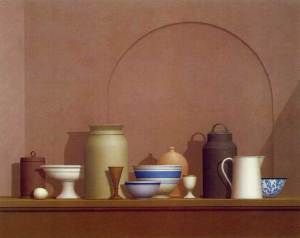 ,
, ,
,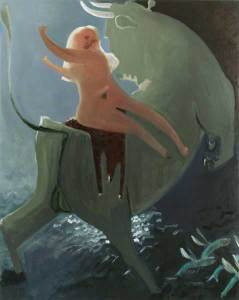
William Bailey Still Life Hotel Raphael 1985 (Credit: Courtesy of the artist and Betty Cuningham Gallery New York),Randall Exon Beach House 2008,Kyle Staver Europa and the Flying Fish 2011
[/table]
In the final category, constructed painting, artists rely more on pictorial invention or working from memory rather than a close observation of a scene in front of them. William Bailey’s tranquil still-life lies on the Apollonian end of the spectrum. At first glance, the vessels that he uses have such compelling presences that it is difficult to believe that he is not looking at them as he paints them. In fact, each of the objects does exist in real life, but Bailey knows them so well that he is able to call them up from memory to act as players on his wholly invented stage. In addition to the crisp edges and desaturated colors that connect Bailey to other painters with more Apollonian features, Bailey has a very interesting way that he deals with perspective. Like the figures in Balthus’ Figure in Front of a Mantel and Euan Uglow’s Nude, 12 Vertical Positions from the Eye, each part of Bailey’s vessels is seen at eyelevel. If the vessels were actually painting according to an observed perspective, then ellipses would be visible at any point above or below the line of sight. Instead, all of Bailey’s objects have straight lines in the place where we would see an ellipse. This sends a very specific message to our brains. The closer we are to a vessel in real life, the greater the effects of perspective would appear, with a correspondingly greater change in the pitch of the ellipses. Conversely, the further the object is from us, the more all of the ellipses would resemble a straight line. As the object approaches the horizon, ellipses are converted to lines. This makes it appear as though Bailey’s vessels are being seen from a great distance, and thus they take on an air of monumentality. We see them as intimate vessels and at the same time our brain reads them as possessing the immensity of the Egyptian Pyramids. The impression is to infuse the paintings with a grandeur that links them to the great architectural achievements of mankind—these pinnacles of the Apollonian drive.
Bailey’s work is not about finding precise color relationships or accurately recording a visual experience; it is much more focused on the internal art historical dialogue that takes place for him while he paints. The colors he employs are the earthy hues of Italy, influenced by the four months of the year that he spends at his home in Umbria. When asked about the serene sense about his work and about whether he is in a transcendent or mystical state while at work, Bailey replied:
I don’t think it’s mystical. When my work changed around 1960, I was thinking, “There’s so much noise in contemporary art. So much gesture.” I realized it wasn’t my natural bent to make a lot of noise and I’m not very good at rhetorical gesture. So this came on a little gradually. With the egg paintings, I started thinking about time and slowing the paintings down and allowing relationships to develop in time and somehow the time I spent in developing those relationships was reflected in the way the image was read. It wasn’t read quickly because it wasn’t painted quickly, and the relationships didn’t reveal themselves easily because they weren’t arrived at easily. And it’s that complication I think that got into the work. The paintings that I know, that I admire like Piero [della Francesca], have that quality, that silence. I’m sure that’s gotten into the work, but I don’t have a formula for it.[9]
Like the observational painters, Bailey distances himself from the classicists by emphasizing the lack of formula in his painting process. The idea, again, is that the pictorial language is one that is invented rather than completely inherited.
Of course, as is the case with each contemporary painter whom I mention in this paper, personal style is an outgrowth of individual temperament as distilled through encounters with art history. The amount to which a language is inherited or invented is always on a sliding scale—it is never purely one or the other. But a dividing point between classical painters and the other two categories is the amount to which the language is inherited, and that is not always the clearest distinction to make. Sometimes painters see themselves as belonging to one camp while other observers may group them with a completely different one. Painters are often wary of labels, and rightly so (especially if said labels serve to limit rather than to deepen our understanding of their work), but when they perceive that their work is being misunderstood to the extent that it is being mislabeled, hackles get raised and we start to see some of the reasoning behind their impassioned responses to work being done in one of the other camps—the better to distance themselves from labels that they find unappealing.
In addition to grappling with art history, painters often are in dialogue with their own personal history. This is the case with Randall Exon’s painting, positioned at a midway point between the Apollonian and the Dionysian in the constructed painting category. His artist statement on his website lays out his goals very clearly:
In his paintings, Exon is interested in the ways in which memory and dreams inform us about the past. Evocation is his primary goal as a “realist,” rather than accuracy. Most of his paintings are fictions made up entirely from collected sources and/or personal experience and memory.[10]
When he was a child living in Kansas, a tornado completely demolished his family home as he sheltered beneath it. He has since developed a large body of work, including the painting shown here, where he recreated an idealized house from his memory and imagination—a house that exists only within his creative work. Exon’s focus on dreams and on rebuilding that which was lost are clearly Apollonian ambitions. His work also tends to be tonalist in nature, with a clear value structure and with color being more tied to evocation and memory than to an experience of observed color in life. But his edges are not as clean and tight as those of William Bailey and the direction of the light is not always as clear, with shadows sometimes functioning more as emotional presences than as formal devices. Through the open windows we are confronted with ominous storm clouds, quietly threatening our Apollonian haven with the specter of external chaos.
Finally, on the Dionysian end of constructed painting we have the work of Kyle Staver. While the subject matter directly quotes from Greek mythology, the pictorial language she uses is very much her own. The figures are painted in a way that is almost cartoonish, yet they are bathed in a silvery, elusive moonlight, which conjures up images of barely glimpsed dances in the thick of forested night. This is not Apollo’s clear light of day, but rather the slipping light of the Dionysian mystery religions. In contrast to William Bailey’s rational grid of vertical and horizontals, Staver’s painting is filled with leaping diagonals that sweep the viewer’s eye on a rollercoaster ride from end to end of her massive painting. The very moments that she depicts are wrought with charged emotion, with the promise of either ecstasy or devastation just around the corner. In his Huffington Post article, Daniel Maidman compares Staver’s view of the myth-image to the more rational, structured, and glossy versions, such as the paintings of nineteenth century English painter Lawrence Alma-Tadema:
We discover that one form of knowledge precludes another, that to know all things born of brightness and identification is to forget things born of darkness and mystery….The myth-image cannot be resolved; we cannot touch the face of Zeus as we can those of our human brothers. Sunlight does not make his features clear. There is a light that lights him, but we do not have the eyes to see that light….One solution is to paint the gods as mortals see them. How do mortals see them? Indistinctly and murkily, by moonlight, with the aspect of a rustle among the leaves or a burst of feathers. A thing blurs past us, and by the time we turn to look at it, it is gone. This is how Kyle Staver paints the myths.[11]
Kyle Staver also uses an indirect manner of painting (glazing, scumbling, and so forth) which is usually associated with classical painters, but her usage is less structured and more about activating the entire surface in an engaging and varied manner. She also uses storytelling in her paintings, which we associate with the Apollonian, but we are somehow convinced that her paintings are less about a story that seems to have a point, and more about the visceral, sensual experience of that specific moment.
What we see is that the division into the three categories of classical, observational, and constructed is very fluid. While there are clearly identifiable tendencies within each group, traits that are ascribed to one group also often show up in others, but to different extents…and they are often used to different ends. Flattening her space like a true modernist, Kyle Staver also glazes. Deeply committed to the act of observation, Israel Hershberg will also move the table stains about on his surfaces, better to serve the composition. Working within an inherited tradition and fully aware of his indebtedness to his painterly predecessors, Daniel Sprick’s paintings are nevertheless so very clearly his own.
Why is there much vitriol between painters in these different camps and between Apollonian and Dionysian painters within the same category? On some level, the divide is a religious one. Apollonian painting, and especially classical painting, tends to be associated with more conservative beliefs that emphasize the importance of traditions passed down over countless generations and a life that is involved with established religious institutions and norms.
Towards the Dionysian side of the spectrum, one finds the mistrust of institutions and received modes of worship, and an emphasis on individual exploration and experience. Similarly, people often jump to political assumptions based on viewing a particular style of painting. Since a more classical and prescribed approach was often utilized by totalitarian regimes (both on the right and the left ends of the political spectrum), painters who favor a more Apollonian style are often accused of simplemindedly, or even maliciously, toeing a party line. On the other hand, painters of a more Dionysian bent can be accused of being untaught, lazy, or even anarchists. And thus contemporary painting becomes a battlefield on which religious, social, and political forces are played out, with gross generalizations bandied about. People jump to oversimplifications, essentializations, and sometimes, discourse that amounts to nothing more than belligerent name-calling.
On a basic level, we are clannish creatures, and we naturally like to think that our way of doing something is the right way of doing something, because it justifies our own decisions. Recent research in neuroaesthetics establishes that the brain’s default mode network (DMN), the part of the brain which is highly associated with personal identity, becomes activated when the subject is viewing those particular artworks which that individual finds most meaningful.[12] The DMN is usually activated during introspection, and is not typically active when an individual is engaged in the outside world…and this includes viewing paintings that do not produce a strong sense of resonance. Thus, current scientific findings confirm what painters have always known: that the language of paint which calls to us most insistently is inextricably linked to our deepest sense of self. In the case of painters, there is an immense amount of time, effort, and psychic energy that goes into the creation of a body of work. It is a truism that when one is not secure in one’s sense of self, a competing vision of the world seems like a personal challenge rather than a fellow traveler’s unique contribution to the rich tapestry that is contemporary painting.

Susan Jane Walp, Nuts in a White Cup with Brick, Pine
Cone, Xerox and Clothespin, 2008. Observational, mixed
Apollonian/Dionysian. Credit: Courtesy of the artist and Tibor de Nagy Gallery, New York
The divide between the Apollonian and the Dionysian represents different urges, both within our society and within ourselves. Historically, these two opposing forces have worked in concert to create civilization and art as we know it. The clarity of the Renaissance, an Apollonian rediscovery and resurrection of the lost artistic knowledge of Classical Greece, was followed by the Dionysian passion of Baroque art. Out of the Baroque rose highly structured Neoclassicism, peaking at the height of the French Academy. And remember that the impressionists, those textbook Dionysian iconoclasts, first rebelled against that Apollonian French Academy—and the impressionists were known for nothing if not breaking down forms and edges (and replacing high-brow subject matter, such as religious themes and classical myths, with more contemporary and unglamorous depictions of urban life). But the Apollonian could not be eradicated, and we are seeing its resurgence now in the greatly renewed interest in both observational painting and in classicism. There are thus great historical cycles within the world of representational art. Apollonian knowledge is lost due to an upsurge of the Dionysian element, during which time the Apollonian becomes occult—it goes into hiding—only to be revived into a great flourishing under the sun once again. The Dionysian upsurge beneficially renews the stale qualities and dogmatic rigidity that, after a while, become sour. Apollo, left to his own devices, becomes stagnant, self-referential, and infatuated with his own perfected sense of order. That is the time for Dionysus and his followers to rage through Apollo’s tidy world, with all the destructive power of their intoxicated orgy, and set the deadwood ablaze to reduce the glorious and bloated construction of culture into unifying and obliterating ash—from which, in time, new seedlings might erupt. During these occulted periods of Apollonian activity under Dionysian sway, the knowledge is refined, misunderstood, and (as a result of that misunderstanding of prior dogmas) creatively reconstructed in a way that allows for the generation of new life. The continuum of the Apollonian and the Dionysian becomes the body of the ouroboros—cyclically eating itself and regenerating through the annals of time.
My hope in exploring these categories and the wide range of Apollonian and Dionysian traits contained in each one is to show that choices of painting style, that visual predilections and affinities, directly result from our deeply rooted response to the chaos inherent in life, and the civilizing forces which struggle to make sense of it. No art can exist without the interrelation of the conflicting tendencies of resisting or embracing the chaos. Nietzsche asserts that Greek tragedy at its artistic height actually fuses these forces together. He believes that the greatest works of art are those in which the conflicting forces are perfectly pitched in creative balance.
We shall have gained much for the science of aesthetics when we have succeeded in perceiving directly, and not only through logical reasoning, that art derives its continuous development from the duality of the Apolline and Dionysiac; just as the reproduction of species depend on the duality of the sexes, with its constant conflicts and only periodically intervening reconciliations.[13]
Whether we are discussing a specific painting, or the entirety of the journey of art through history, progress and renewal are achieved through this battle of the gods. The Apollonian drive brings the possibility of wholeness and balance to our fragmented existence. But with time and institutionalization, Apollo can become self-satisfied—bloated with his own importance—and then only Dionysus can come through to destroy that which has become stagnant, and reunite Man with his essential nature, the source of both his deepest terror and his most profound bliss.
With representational painting having been marginalized for so long as too unhip for the contemporary scene, in its current energetic resurgence, may we spend less time arguing the validity of one approach over another, but rather revel in the tremendous accomplishments that can be found within the rich field of painterly choice that lies open to us. Successful work in each category can lie anywhere within the range of the Apollonian/Dionysian dialectic. We see that Apollonian and Dionysian traits can take a myriad of forms within a single painting, and that every individual painter is responsible for finding the unique way in which these forces are pitched in his or her art. It is the suspended tension of both Apollo and Dionysus within a single work of art that can elevate a painting from simply competent to startlingly and poetically alive.
[1] M. Rogers, “Researchers debunk myth of “right brain” and “left-brain” personality trait.” (Online: University of Utah, Office of Public Affairs. 2013). Retrieved Feb. 22, 2014, from http://www.plosone.org/article/info%3Adoi%2F10.1371%2Fjournal.pone.0071275
[2] Friedrich Nietzsche (Shaun Whiteside, trans.), The Birth of Tragedy out of the Spirit of Music (New York: Penguin Books, 1993), 15.
[3] Arthur Schopenhauer (E.F.J. Payne, trans.), The World as Will and Representation, Vol. I (New York: Dover Publications, 1968), 352.
[4] Nietzsche,16
[5] Heinrich Wölfflin (M.D. Hottinger, trans.), Principles of Art History: The Problem of the Development of Style in Later Art” (New York: Dover Books, 1950), 18. This edition is an unabridged and unaltered reprint of Hottinger’s 1932 translation of Wölfflin’s Kunstgeschichtliche Grundbegriffe (Berlin: G. Bell and Sons, Ltd., 1932).
[6] Idem., 11.
[7] Idem., 10.
[8] Clement Greenberg, “Modernist Painting,” in Forum Lectures (Washington, D.C.: Voice of America, 1960).
[9] Dorie Baker, “The ‘made up’ world of artist William Bailey” (Online: Yale News, Dec. 10, 2010). Retrieved Feb. 24, 2014 from http://news.yale.edu/2010/12/10/made-world-artist-william-bailey.
[10] Randall Exon, “About the Artist” (Online: Randall Exon, 2010). Retrieved Feb. 24, 2014 from http://randallexon.com/Abouttheartist.html.
[11] Daniel Maidman, “Theophany: Kyle Staver’s Greek Myth Paintings at Tibor de Nagy Gallery” (Online: Huffington Post, Oct. 16, 2013). Retrieved Feb. 25, 2014 from http://www.huffingtonpost.com/daniel-maidman/theophany-kyle-stavers-gr_b_4102690.html.
[12] Allison Meier, “Neuroaesthetic Research Probes Link Between Art, Perception, and the Self” (Online: Hyperallergic, Jan. 23, 2014). Retrieved Feb. 25, 2014 from http://hyperallergic.com/104767/neuroaesthetic-research-probes-link-between-art-perception-and-the-self/.
[13] Nietzsche, 14.

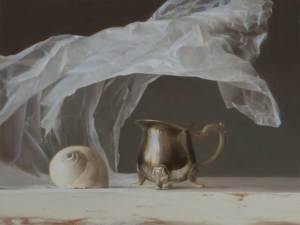
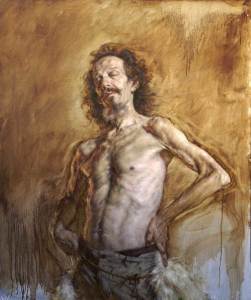
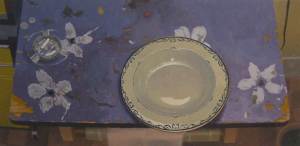
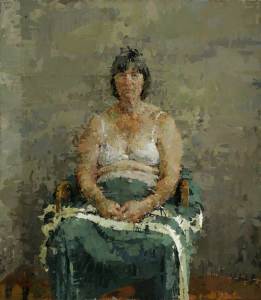
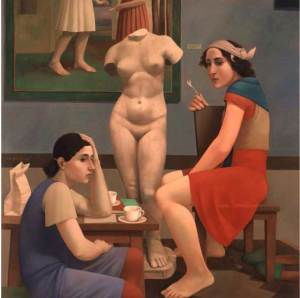
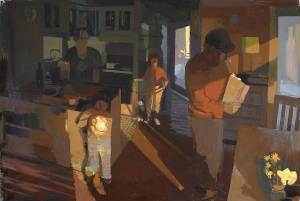




A wonderful analysis of the Appolonian and Dionysian in the representational painting tradition. Thank you for this article. I first was introduced to Nietzsche’s concept when in art school at LCAD. Clayton Garrison was my critical thinking teacher then. It’s always stuck with me.
Great insights and comparisons of the philosophies in representational painting aesthetics. I find it intriguing how an artist’s instincts would guide them one way or another in the development of their style – influences from environment, exposure or an emotional affinity toward a specific type of approach. It made me ponder in which category my work would fall in!
What an odd essay. Is there really “so much vitriol between different artistic camps” as Hagler suggests? Who are the “many respected and established artists (who) are at each other’s throats” over the different styles of painting choices? Personally, I’m not engaging in “outrageously unprofessional behavior arising out of aesthetic disagreements”. Are you? Do you know of any painters who are?
Hagler writes “For decades now, it has been widely asserted that any type of realism (which is in itself a loaded word) is passé, and therefore it has been actively marginalized by many mainstream critics and contemporary art institutions.” Is that really true? Without even trying I can think of 1/2 dozen well respected NYC galleries than deal with artists whose subjects works around realism in some manner. We live in an exciting time in painting today where no one style or manner of making paintings is ruling the roost. Isn’t it time we lay these tired old cliches to rest?
You said it Richard!
“Without even trying I can think of 1/2 dozen well respected NYC galleries than deal with artists whose subjects works around realism in some manner. We live in an exciting time in painting today where no one style or manner of making paintings is ruling the roost. Isn’t it time we lay these tired old cliches to rest?”
–Exceptionally well said.
Thank you for your kind words, Kyle and Christopher. I appreciate your comments.
Richard, I also appreciate the questions that you bring up. I think it’s wonderful that you have not personally witnessed such negative and dismissive responses to aesthetic choices. May things continue to move more in that direction! Sadly, these incidents occur all too often, particularly in art schools and institutions, where the next generation of artists is coming up. I like to think that the further we get from the art school experience, the less of this kind of behavior we find, but even that is not always the case. As far as your question of “do you know of any painters who are [fighting it out],” I’m not in the business of naming names, but the answer is an emphatic “yes, and how!” I suppose with any sort of perceived bias, those who have not seen such behavior in action might reasonably doubt its existence, so I’ll just leave it to readers to make their own observations in this regard.
My claim of “realism” being marginalized for decades is hardly an original one, but I do think that it is making more and more of a comeback. In fact, its current vibrancy and diversity is part of what inspired me to write this essay.
Elana,
You’re on target. You are so on target. Brilliant essay! Beautifully written.
It has simply been Apollo and Dionysus in my head all these years! I’m not crazy after all!! I Can’t wait to tell my wife!!!
Noel
Elana,
Thank you for helping me to see my daily, rather elementary, struggles in painting within the greater context of the glorious dynamism of art itself. This is a masterfully integrated essay.
And thanks as always to Larry for generously providing consistently excellent posts.
All the very best wishes in the new year to you and those you love,
Donna
Thank you. I know a lot less about contemporary painting than I do about 19th century philosophy; this article has helped to bridge the divide.
Elana,
I enjoyed reading this essay, a lively and clear description of different modes of representation. It’s helpful in navigating the constructs of the figurative holy wars, and makes an intelligent argument for dispensing with the individual ego and recognizing a pluralistic environment. This defuses a lot of the proprietary tensions that tend to build between the different schools of realism. The constructs the essay offers are helpful in the broader aesthetic arena, since the implication is that non-representational modes of art may be similarly understood. I suspect some of the unmentioned reasons for the strong antipathy between schools–outside the province of this essay–are those which impact behavior in academia as well: issues of power, preeminence, and the attendant financial and career ramifications. These tensions are enhanced in an environment where most of the participants view themselves as marginalized.
Very good reading. Thank you,
Jerry
A wonderful article, thank you Elana!